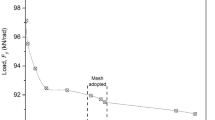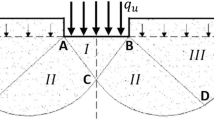Abstract
During installation, the helical pile should penetrate into the ground at a rate equal to one helix pitch per rotation to prevent additional soil disturbance, as usually recommended in installation guides; however, in the field this is frequently difficult to achieve. To have a better understanding of the effects of the advancement rate (AR) on the installation torque and helix bearing capacity, six calibration chamber tests were performed on an instrumented single-helix pile installed in very dense sand using three different AR values (0.8, 1 and 1.2). For the range tested, the results indicated that AR affects the uplift and compressive capacity of the pile helix. A reduction in compressive capacity of 24% on average was observed for AR of 0.8, compared to the recommended pitch matched installation (AR = 1), while for AR of 1.2, the compressive capacity increased 12% on average. In uplift, the capacity variation was about − 26% and + 6%, respectively, for AR of 0.8 and 1.2 compared to the pitch matched installation case. The effect of AR was also observed for the capacity-to-torque factor related to the helix portion of a deep helical pile and suggests the necessity for monitoring AR to ensure the applicability of the torque factor for pile capacity control.














Similar content being viewed by others
Availability of data and material
Data will be available on reasonable request.
Abbreviations
- d :
-
Pile shaft diameter
- q h :
-
Helix bearing pressure
- q h-C :
-
Helix bearing pressure in compression
- q h-T :
-
Helix bearing pressure in uplift
- AR:
-
Installation advancement rate
- C u :
-
Coefficient of uniformity of the sand
- D :
-
Helical plate diameter
- D/d :
-
Helix-to-shaft diameter ratio
- D r :
-
Relative density of sand
- F h-inst(max) :
-
Maximum installation crowd force at the instrumented section
- G s :
-
Specific gravity of the sand particles
- K C :
-
Compressive total torque factor
- K C-helix :
-
Compressive torque factor related to the helix and tip portion
- K T :
-
Tensile total torque factor
- K T-helix :
-
Tensile torque factor related to the helix portion
- Q h-C :
-
Compressive helix bearing capacity
- Q h-T :
-
Tensile helix bearing capacity
- T h :
-
Installation torque related to the helix portion
- U :
-
Pile head axial displacement
- ϕ cv :
-
Angle of shearing resistance at constant volume
- ϕ peak :
-
Angle of shearing resistance at peak
- γ d :
-
Soil dry unit weight
- γ d(max) :
-
Soil maximum dry unit weight
- γ d(min) :
-
Soil minimum dry unit weight
- σ r :
-
Radial stress
- σ ri :
-
Initial radial stress
- σ v :
-
Vertical stress
- σ v0 :
-
Vertical surcharge
- σ vi :
-
Initial vertical stress
References
ASTM (2013) Standard test method for individual piles under static axial tensile load. ASTM International, West Conshohocken
ASTM (2013) Standard test methods for deep foundations under static axial compressive load. ASTM International, West Conshohocken
Al-Baghdadi T (2018) Screw piles as offshore foundations: numerical and physical modelling. Doctoral dissertation, University of Dundee, Dundee, Scotland, UK
Andreadis A, Harvey RC, Burley E (1981) Embedded anchor response to uplift loading. J Geotech Eng Div 151(1):59–78
Bradshaw AS, Zuelke R, Robertson T, et al (2019) Physical modelling of a helical pile installed in sand under constant crowd. In: Proceedings of 1st International Symposium on screw piles for energy applications. University of Dundee, Dundee, UK, pp 109–115
Byrne BW, Houlsby GT (2015) Helical piles: an innovative foundation design option for offshore wind turbines. Philos Trans R Soc A Math Phys Eng Sci 373(2035):1–11
CCC (Chance Civil Construction) (2012) Guide to model specification: helical piles for structural support. Bulletin 01–0303 Specification Guide. Chance Civil Construction, Centralia, MO, USA
Cerfontaine B, Brown MJ, Knappett JA et al (2021) Control of screw pile installation to optimise performance for offshore energy applications. Géotechnique. https://doi.org/10.1680/jgeot.21.00118
Clemence SP, Pepe FD (1984) Measurement of lateral stress around multihelix anchors in sand. Geotech Testing J 7(3):145–152
Davidson C, Al-Baghdadi T, Brown MJ, Brennan A, Knappett JA, Augarde C, Coombs W, Wang L, Richards DJ, Blake A, Ball J (2018) Centrifuge modelling of screw piles for offshore wind energy foundations. In: McNamara A, Divall S, Goodey R, Taylor N, Stallebrass S, Panchal J (eds) Physical modelling in geotechnics. CRC Press, pp 696–700. https://doi.org/10.1201/9780429438660-104
Ding H, Wang L, Zhang P et al (2019) The recycling torque of a single-plate helical pile for offshore wind turbines in dense sand. Appl Sci 9(19):4105
Elsherbiny ZH, El Naggar MH (2013) Axial compressive capacity of helical piles from field tests and numerical study. Can Geotech J 50(12):1191–1203
Elsherbiny Z, El Naggar MH, Elgamal A (2019) Effects of helical pile installation on the lateral stiffness for piles in dense sand. In: Proceedings of 1st International Symposium on Screw Piles for Energy Applications. University of Dundee, Dundee, UK, pp 87–94
Garnier J, Gaudin C, Springman SM et al (2007) Catalogue of scaling laws and similitude questions in geotechnical centrifuge modelling. Int J Phys Model Geotech 7(3):1–23
Gaudin C, O’Loughlin CD, Randolph MF et al (2014) Advances in offshore and onshore anchoring solutions. Australian Geomech 49(4):59–72
Gavin K, Doherty P, Tolooiyan A (2014) Field investigation of the axial resistance of helical piles in dense sand. Can Geotech J 51(11):1343–1354
Ghaly A, Hanna A (1991) Experimental and theoretical studies on installation torque of screw anchors. Can Geotech J 28(3):353–364
Harnish J, El Naggar MH (2017) Large-diameter helical pile capacity–torque correlations. Can Geotech J 54(7):968–986
Hussein AF, El Naggar MH (2022) Dynamic performance of driven and helical piles in cohesive soil. Acta Geotech. https://doi.org/10.1007/s11440-022-01649-8
Kulhawy FH, Mayne PW (1990) Manual on estimating soil properties for foundation design (No. EPRI-EL-6800). Electric Power Research Institute, Palo Alto, CA, USA
Lee J, Kwon O, Kim I et al (2019) Cyclic pullout behavior of helical anchors for under inclined loading condition. Appl Ocean R 92:101937
Li W, Deng L (2019) Axial load tests and numerical modeling of single-helix piles in cohesive and cohesionless soils. Acta Geotech 14:461–475
Lutenegger AJ, Erikson J, Williams N (2014) Evaluating installation disturbance of helical anchors in clay from field vane tests. In: Proceedings of 39th Annual Conference on Deep Foundations. DFI, Atlanta, GA, USA, pp 129–138
Lutenegger AJ (2019) Screw piles and helical anchors: what we know and what we don’t know: an academic perspective. In: Proceedings of 1st International Symposium on screw piles for energy applications. University of Dundee, Dundee, UK, pp 15–28
Lutenegger AJ, Tsuha CHC (2015) Evaluating installation disturbance from helical piles and anchors using compression and tension tests. In: Proceedings of XV Panamerican Conference on soil mechanics and geotechnical engineering. IOS Press, Buenos Aires, Argentina, pp 373–381
Mitsch MP, Clemence SP (1985) The uplift capacity of helical anchors in sand. Uplift behaviour of anchor foundations in soil. ASCE, New York, pp 26–47
Mosquera ZS, Tsuha CHC, Schiavon JA et al (2015) Discussion of “Field investigation of the axial resistance of helical piles in dense sand.” Can Geotech J 52(8):1190–1194
Murthy VNS (2003) Geotechnical engineering: principles and practices of soil mechanics and foundation engineering. CRC Press, Boca Raton
NYBC (2014) International Code Council. NYC Buildings, New York
Nagai H, Tsuchiya T, Shimada M (2018) Influence of installation method on performance of screwed pile and evaluation of pulling resistance. Soils Found 58(2):355–369
O’Neill MW (1991) Houston’s calibration chamber: case histories. In: Proceedings of 1st Symposium on calibration chamber testing, Potsdam, NY, pp 277–288
Perko HA (2009) Helical piles: a practical guide to design and installation. Wiley, Hoboken
Pessin J, Formigari RC, Tsuha CHC (2021) Effect of the groundwater flow on the ground temperature response of an energy pile in sand. In: Proceedings of 3rd Asian Conference on Physical Modelling in Geotechnics. National University of Singapore, Singapore, pp 153–162
Pérez ZA, Schiavon JA, Tsuha CHC et al (2018) Numerical and experimental study on influence of installation effects on behaviour of helical anchors in very dense sand. Can Geotech J 55(8):1067–1080
Rafsanjani AAH, Salehzadeh H, Nuri H (2021) Evaluating scale effects and bearing portions in centrifuge modeling of helical anchors: sand. Acta Geotech 16:2917–2932
Sakr M (2009) Performance of helical piles in oil sand. Can Geotech J 46(9):1046–1061
Schiavon JA, Tsuha CHC, Thorel L (2016) Scale effect in centrifuge tests of helical anchors in sand. Int J Phys Model Geotech 16(4):185–196
Seider PE, Clemence SP, Hoyt R, et al (2015) Model specification for helical anchor foundations tension applications. DFI Publication TM-HLPR-1. DFI, Hawthorne, NJ, USA
Shahbazi M, Cerato AB, Hassan EM et al (2022) Seismic risk assessment of a steel building supported on helical pile groups. Acta Geotech 17:289–301
Sharif YU, Brown M, Cerfontaine B et al (2020) Effects of screw pile installation on installation requirements and in-service performance using the discrete element method. Can Geotech J 58(9):1334–1350
Silva DM, Tsuha CHC (2021) Experimental investigation on the installation and loading performance of model-scale deep helical piles in very dense sand. Can Geotech J 58(9):1379–1395
Silva DM (2020) A calibration chamber study of helical piles in very dense sand. Doctoral thesis, University of São Paulo, São Carlos, Brazil (in Portuguese)
Spagnoli G, Gavin K (2015) Helical piles as a novel foundation system for offshore piled facilities. In: Proceedings of Abu Dhabi International Petroleum Exhibition and Conference. Curran Associates, Red Hook, New York, USA, pp 1–12
Ullah SN, Hu Y, O'Loughlin C (2019) A green foundation for offshore wind energy-helical piles. In: Proceedings of world engineers convention 2019, Melbourne, Engineers Australia, Barton, Australia, pp 272–285
Wang L, Zhang P, Ding H et al (2020) The uplift capacity of single-plate helical pile in shallow dense sand including the influence of installation. Mar Struct 71:102679
Yang J (2006) Influence zone for end bearing of piles in sand. J Geotech Geoenviron Eng 132(9):1229–1237
Acknowledgements
The authors thanks to Dr. Diego Moreira da Silva for his support during the experimental program and for the photographs provided, and acknowledge the financial support given by the National Council for Scientific and Technological Development-CNPQ for the financial support to this work (Process 425770/2016-8 and 310881/2018-8), and for granting the Master’s scholarship of the first author.
Funding
Partial financial support was received from the National Council for Scientific and Technological Development-CNPq-under Grants numbers 425770/2016-8 and 310881/2018-8, and postgraduate scholarship granted to the first author.
Author information
Authors and Affiliations
Corresponding author
Ethics declarations
Conflict of interest
The authors declare that there are no conflicts of interest of any nature.
Additional information
Publisher's Note
Springer Nature remains neutral with regard to jurisdictional claims in published maps and institutional affiliations.
Rights and permissions
Springer Nature or its licensor holds exclusive rights to this article under a publishing agreement with the author(s) or other rightsholder(s); author self-archiving of the accepted manuscript version of this article is solely governed by the terms of such publishing agreement and applicable law.
About this article
Cite this article
Annicchini, M.M., Schiavon, J.A. & Tsuha, C. Effects of installation advancement rate on helical pile helix behavior in very dense sand. Acta Geotech. 18, 2795–2811 (2023). https://doi.org/10.1007/s11440-022-01713-3
Received:
Accepted:
Published:
Issue Date:
DOI: https://doi.org/10.1007/s11440-022-01713-3




